| Linked Data is a set of practices which involves the publishing, sharing, and connecting of related data across the Web in a structured format, preferably using an open access license. |
Why use Linked Data?
Using Linked Data is a way to make online library resources—even those items having metadata and located in online library catalogs—accessible to the Web at large by publishing the data in a standard, openly-accessible way.
Properly described and published, online library resources could be harvested by search engines and linked to from other online resources. In order to do this, Linked Data must be structured in a standard way for the Web.
On the cataloging and description side, Linked Data from online resources such as the Virtual International Authority File (VIAF) can serve as global authority records.
The Basics
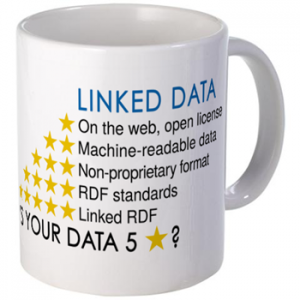 Tim Berners-Lee defined his four principles of Linked Data in 2009:
Tim Berners-Lee defined his four principles of Linked Data in 2009:
- Use URIs as names for things
- Use HTTP URIs so that people can look up those names
- When someone looks up a URI, provide useful information, using the standards (RDF*, SPARQL)
- Include links to other URIs so that they can discover more things.
Linked Data has two components: URI and RDF.
URI (Uniform Resource Identifier) is a location as name of a digital resource on the Web, typically given in the form of a Uniform Resource Locator (URL) that also gives the protocol (ex. HTTP) of accessing it.
RDF (Resource Description Framework) is a standard structured file (often in XML) which describes a digital resource and contains URIs.
For a Linked Data statement, you need three components: subject, predicate, and object. These together are referred to as a triple.
<subject> <predicate> <object>
Subject – what’s being described and linked, a URI or blank node.
Predicate – describes the connection, always a URI.
Object – the resource being linked to, a URI, literal, or blank node.
<Atlas Shrugged> <was created by> <Ayn Rand>
One framework for moving library metadata records into Linked Data format is BIBFRAME, the replacement for MARC being developed by the Library of Congress and others. We will continue to see new tools created for the conversion of library metadata formats (such as Dublin Core) into Linked Data formats (such as RDF/XML and Turtle).
Finally, as more library records are converted and made available as Linked Data, we will see library vendors start to utilize Linked Data in their products. For example, Ex Libris recently announced that the company has launched a program to “harness linked data technology in its resource management and discovery solutions” and published the paper Putting Linked Data at the Service of Libraries.
Resources
Here are some great online resources to learn about Linked Data:
- Libhub Resources – Links to BIBFRAME and Linked Data Web resources, articles and books, tools, organizations, and videos.
- Linked Data – Connect Distributed Data across the Web – A very thorough resource with guides and tutorials, FAQ, presentations, data sets, and more.
- Linked Data for Libraries – Site for Linked Data for Libraries (LD4L) project.
- OCLC Linked Data – OCLC’s Linked Data initiatives and the status of Linked Data in WorldCat.
- UNLV’s Linked Data Project – Blog posts from 2014 contain some good information and presentations on Linked Data.
- WC3 – Data (Linked Data) – Semantic Web and Linked Data definition and examples with a link to specifications such as RDF.
Articles and books about Linked Data and libraries:
Common Ground: Exploring Compatibilities Between the Linked Data Models of the Library of Congress and OCLC by Carol Jean Godby and Ray Denenberg
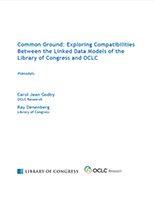 “Jointly released by OCLC and the Library of Congress, this white paper compares and contrasts the compatible linked data initiatives at both institutions. It is an executive summary of a more detailed technical analysis that will be released later this year.” Published in 2015.
“Jointly released by OCLC and the Library of Congress, this white paper compares and contrasts the compatible linked data initiatives at both institutions. It is an executive summary of a more detailed technical analysis that will be released later this year.” Published in 2015.
Access the abstract and full-text article (PDF).
Library Linked Data in the Cloud: OCLC’s Experiments with New Models of Resource Description by Carol Jean Godby, Shenghui Wang, and Jeffrey K. Mixter
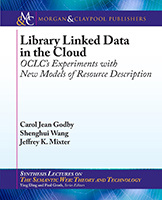 Part of the “Synthesis Lectures on the Semantic Web: Theory and Technology” series. OCLC looks at Linked Data in cataloging and its products. Topics include authority records including VIAF, cataloging and FRBR, text mining, and the library Linked Data cloud. Published in 2015.
Part of the “Synthesis Lectures on the Semantic Web: Theory and Technology” series. OCLC looks at Linked Data in cataloging and its products. Topics include authority records including VIAF, cataloging and FRBR, text mining, and the library Linked Data cloud. Published in 2015.
Watch the companion video (59:50).
View details and find a place to buy or borrow at Google Books.
Library Linked Data: Research and Adoption by Erik T. Mitchell
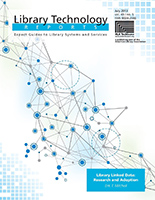 This title is actually an issue of Library Technology Reports from ALA Tech Source. The report covers basic metadata in libraries and museums, Linked Open Data (LOD), case studies including BIBFRAME, and “issues, opportunities, and trends” in metadata. Published in 2013.
This title is actually an issue of Library Technology Reports from ALA Tech Source. The report covers basic metadata in libraries and museums, Linked Open Data (LOD), case studies including BIBFRAME, and “issues, opportunities, and trends” in metadata. Published in 2013.
View details and find a place to buy or borrow at Google Books.
Linked Data for Libraries, Archives and Museums: How to Clean, Link and Publish your Metadata by Seth van Hooland and Ruben Verborgh
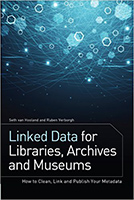 In this book published by the American Library Association, the authors cover Linked Data and focus on the metadata standards supporting it. They present key concepts of metadata including metadata modelling, cleaning, reconciling, enriching, and publishing. Published in 2014.
In this book published by the American Library Association, the authors cover Linked Data and focus on the metadata standards supporting it. They present key concepts of metadata including metadata modelling, cleaning, reconciling, enriching, and publishing. Published in 2014.
View details and find a place to buy or borrow at Google Books.
